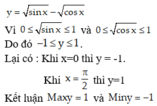Hãy nhập câu hỏi của bạn vào đây, nếu là tài khoản VIP, bạn sẽ được ưu tiên trả lời.

\(y=2cos^2x-2\sqrt{3}sinx.cosx+1\)
\(=2cos^2x-1-2\sqrt{3}sinx.cosx+2\)
\(=cos2x-\sqrt{3}sin2x+2\)
\(=2\left(\dfrac{1}{2}cos2x-\dfrac{\sqrt{3}}{2}sin2x\right)+2\)
\(=2cos\left(2x+\dfrac{\pi}{3}\right)+2\)
Ta có: \(cos\left(2x+\dfrac{\pi}{3}\right)\in\left[-1;1\right]\)
\(\Rightarrow min=0\Leftrightarrow cos\left(2x+\dfrac{\pi}{3}\right)=-1\Leftrightarrow2x+\dfrac{\pi}{3}=\pi+k2\pi\Leftrightarrow x=\dfrac{\pi}{3}+k\pi\)
\(\Rightarrow max=4\Leftrightarrow cos\left(2x+\dfrac{\pi}{3}\right)=1\Leftrightarrow2x+\dfrac{\pi}{3}=k2\pi\Leftrightarrow x=-\dfrac{\pi}{6}+\dfrac{k\pi}{2}\)
\(y=2cos^2x-\sqrt{3}sin2x+1=cos2x-\sqrt{3}sin2x+2\)
\(y=2.cos\left(2x+\dfrac{\pi}{3}\right)+2\)
\(\forall x\in R->-1\le cos\left(2x+\dfrac{\pi}{3}\right)\)
=> \(Min_y=2.\left(-1\right)+2=0\)
Mặt khác, theo Bunhiacopxki:
\(\left(cos2x+\sqrt{3}sin2x\right)^2\le\left(1^2+\sqrt{3}^2\right)\left(cos^22x+sin^22x\right)=4\)
=>\(Max_y=4\)

Xét − sin x + 2 cos x + 4 = 0
Ta thấy − 1 2 + 2 2 < 4 2 nên phương trình vô nghiệm.
Do đó − sin x + 2 cos x + 4 ≠ 0 .
Như vậy, y = 2 sin x + cos x + 3 − sin x + 2 cos x + 4
⇔ y − sin x + 2 cos x + 4 = 2 sin x + cos x + 3
⇔ sin x 2 + y + cos x 1 − 2 y + 3 − 4 y = 0
Để phương trình có nghiệm thì 2 + y 2 + 1 − 2 y 2 ≥ 3 − 4 y 2
⇔ 5 y 2 + 5 ≥ 16 y 2 − 24 y + 9
⇔ 11 y 2 − 24 y + 4 ≤ 0
⇔ 2 11 ≤ y ≤ 2
Chọn đáp án D.

\(ĐK:sinx-cosx\ne-2\)
\(< =>2y-1=sinx\left(1-y\right)+cosx\left(y+3\right)\)
Theo Bunhiacopxki:
\(\left[sinx\left(1-y\right)+cosx\left(y+3\right)\right]^2\)\(\le\left(sin^2x+cos^2x\right)\left[\left(1-y\right)^2+\left(y+3\right)^2\right]\)
\(< =>\left(2y-1\right)^2\le2y^2+4y+10\)
\(< =>2y^2-8y-9\le0\)
=> Bấm máy tìm Max, Min của y
(Sry máy tính của t bị ngáo không bấm ra)
\(\Rightarrow y.sinx-y.cosx+2y=sinx+3cosx+1\)
\(\Rightarrow\left(y-1\right)sinx-\left(y+3\right)cosx=1-2y\)
Theo điều kiện có nghiệm của pt lượng giác bậc nhất
\(\Rightarrow\left(y-1\right)^2+\left(y+3\right)^2\ge\left(1-2y\right)^2\)
\(\Leftrightarrow2y^2-8y-9\le0\)
\(\Rightarrow\dfrac{4-\sqrt{34}}{2}\le y\le\dfrac{4+\sqrt{34}}{2}\)
\(y_{max}=\dfrac{4+\sqrt{34}}{2}\) ; \(y_{min}=\dfrac{4-\sqrt{34}}{2}\)

a: ĐKXĐ: 2x<>kpi và cot2x<>-1/căn 3
=>x<>kpi/2 và 2x<>-pi/3+kpi
=>x<>kpi/2 và x<>-pi/6+kpi/2
b: -1<=cos(2x+pi/5)<=1
=>-4<=4cos(2x+pi/5)<=4
=>5<=y<=13
y=5 khi 2x+pi/5=pi+k2pi
=>x=2/5pi+kpi
y=13 khi 2x+pi/5=k2pi
=>x=kpi-pi/10

1. Không dịch được đề
2.
\(-1\le cos2x\le1\Rightarrow1\le y\le3\)
3.
a. \(-2\le2sinx\le2\Rightarrow-1\le y\le3\)
\(y_{min}=-1\) khi \(sinx=-1\Rightarrow x=-\dfrac{\pi}{2}+k2\pi\)
\(y_{max}=3\) khi \(sinx=1\Rightarrow x=\dfrac{\pi}{2}+k2\pi\)
b.
\(0\le cos^2x\le1\Rightarrow-1\le y\le2\)
\(y_{min}=-1\) khi \(cos^2x=1\Rightarrow x=k\pi\)
\(y_{max}=2\) khi \(cosx=0\Rightarrow x=\dfrac{\pi}{2}+k\pi\)
4.
\(y=\left(tanx-1\right)^2+2\ge2\)
\(y_{min}=2\) khi \(tanx=1\Rightarrow x=\dfrac{\pi}{4}+k\pi\)